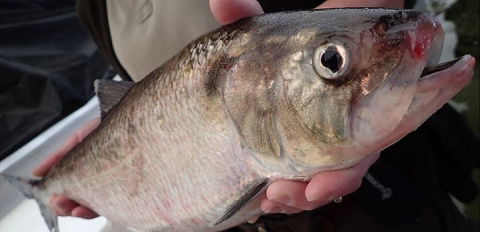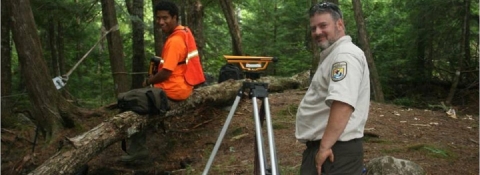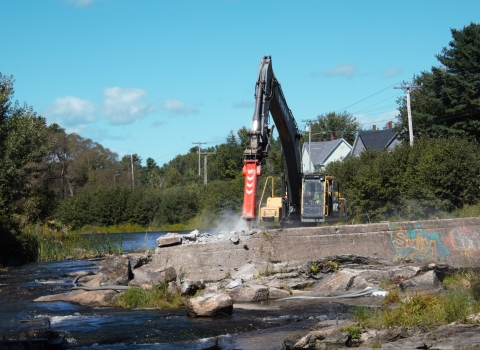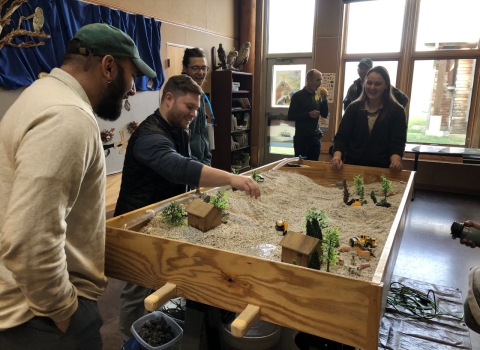Management and Conservation
Migratory Fish Restoration Benefits Everyone!
Each spring, hundreds of thousands of fish migrate from the ocean to the rivers in Maine; alewife and blueback herring, American eel and American shad, Atlantic salmon and Atlantic sturgeon, and striped bass. These fish are ecologically, culturally and economically important to the region as an important food source for people, and for other fish and wildlife, including fish and wildlife that people like to eat. Indeed, restoring these important migratory fishes and resident fish, like the eastern brook trout, are priorities for us. We are removing obstacles to migration, and creating fishways so fish can migrate around dams.
Alewife and Blueback herring were almost considered endangered, but they are beginning to show improvement in a few rivers. Alewife is the preferred bait for lobstermen. Restoring the alewife will help local lobstermen by providing them with fresh, inexpensive and better quality bait.
American shad were greatly affected by pollution and dams, and their numbers are still well below historical levels throughout their range. Some rivers, however, are showing improved runs of shad.
American eel once made up over a quarter of the total fish found in Atlantic coastal streams. Biologists are working on ways to move eels up and downstream of dams.
Atlantic salmon and Atlantic sturgeon are endangered because of overfishing and decades of not being able to reach their home river spawning grounds to produce new generations of fish. Opening rivers so they can reach their spawning grounds is critical to their survival.
Aquatic Connectivity
Americans derive significant economic and recreational enjoyment from fishing. Aquatic habitat loss and degradation, and lack of connectivity between spawning, nursery and feeding grounds are key factors that have caused the decline of fish in the United States. Restoring connectivity between rivers and their floodplain, and between rivers and wetlands and the ocean, will help increase the abundance of fish - and those economic and recreational benefits derived from fishing. Additionally, there are strong environmental and economic reasons for restoring rivers and wetlands like pollution reduction, temperature regulation, water supply recharge and flood control. For example, road crossings or culverts that are engineered so fish can move freely up and down the river, are more likely to survive extreme weather events and flooding such as seen after tropical storms and hurricanes.
For these reasons, the U.S. Fish and Wildlife Service is working to remove obstructions to fish movement, prevent loss of wetlands, and conserve and restore the quantity and quality of aquatic habitat.
On the Ground Restoration
Approximately 45% of more than 5,000 road-stream crossings surveyed on public lands in Maine represent physical barriers to fish migration. These are usually undersized, perched and debris-blocked culverts or bridges. Additionally, many remnant log-drive dams and hydroelectric dams are also blocking fish migration up and down Maine's rivers.
We are working on a state-wide assessment of these road-stream crossings and dams, and identifying where these structures have altered natural stream function or are barriers for fish passage fish passage
Fish passage is the ability of fish or other aquatic species to move freely throughout their life to find food, reproduce, and complete their natural migration cycles. Millions of barriers to fish passage across the country are fragmenting habitat and leading to species declines. The U.S. Fish and Wildlife Service's National Fish Passage Program is working to reconnect watersheds to benefit both wildlife and people.
Learn more about fish passage . We are working with our partners to prioritize these structures for replacement or removal.
Since 2005, the Maine Fish and Wildlife Conservation Office has assisted State partners in completing 196 aquatic connectivity projects. These projects restored fish passage and ecological function to more than 650 miles of stream habitat. We removed barriers and replaced them with structures, such as bridges or open-arch culverts that span at least 1.2 times the bank-full width of the natural stream. Nearly all of these restoration efforts have been conducted within designated critical habitat for endangered Atlantic salmon.
Our Services
Habitat Restoration Funding
Our office coordinates two habitat restoration programs for Maine.
The National Fish Passage Program (NFPP) is a voluntary, non-regulatory initiative of the U.S. Fish and Wildlife Service that provides funding and technical assistance to reconnect aquatic habitat by removing or bypassing barriers. Explore our regional webpage for more information on fish passage fish passage
Fish passage is the ability of fish or other aquatic species to move freely throughout their life to find food, reproduce, and complete their natural migration cycles. Millions of barriers to fish passage across the country are fragmenting habitat and leading to species declines. The U.S. Fish and Wildlife Service's National Fish Passage Program is working to reconnect watersheds to benefit both wildlife and people.
Learn more about fish passage and fish passage engineering services.
And
The National Fish Habitat Partnership (NFHAP) mission is to protect, restore and enhance the nation's fish and aquatic communities through partnerships that foster fish habitat conservation and improve the quality of life for the American people. Our office works with partners to submit quality proposals for two regional NFHAP programs:
Our Projects and Research
The China Lake Outlet Stream Restoration Project will restore connectivity through the entire Outlet Stream in central Maine, opening fish passage from China Lake's incredible 3,939 acres of alewife spawning and nursery habitat to the mainstem Sebasticook and Kennebec Rivers, which flow into the Atlantic Ocean. Formerly, six barriers prevented fish passage along the stream.
...
The project to remove two dams—the Upper Town Dam and the Remnant Mill Dam—from the Sabattus River, a tributary to the Androscoggin River in Maine, has been successfully completed. Both dams were removed, accompanied by bank restoration, stabilization, and revegetation efforts.
These removals have eliminated public safety hazards, reduced flooding risk, and restored parks, providing safe...
Across the landscape, undersized, aging and improperly placed road-stream crossings create barriers in our rivers, streams, and tidal wetlands. These structures fragment aquatic habitat and prevent or greatly reduce the ability of aquatic species to move freely to migrate, feed, and reproduce. These poorly designed structures are also more prone to clogging, causing flooding, and washing out...







